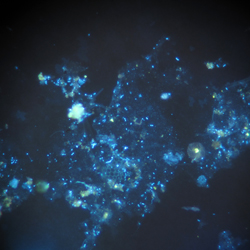Collaborators Tracy Mincer, Benjamin Van Mooy, and Laura Hmelo, from the Wood’s Hole Oceanographic Institution's Marine Biogeochemical Department, have recently found evidence linking marine microbial communication in sinking particulate matter to the efficiency of carbon cycling in the ocean. As detrital organic matter rains down the water column it is rapidly colonized by heterotrophic bacteria. These microbes secrete enzymes into their carbon rich environment degrading the large organic structures into nutrients of usable scale. This process is so efficient that roughly 10% of these organic particles make it to the deep waters. It is only at such depths that carbon can be effectively removed from the atmosphere for thousands of years. This substantial quantity of carbon respired into the atmosphere has a large impact on the marine food web as well as the global climate.
Using organic particles collected off of Vancouver Island, the WHOI team was able to show that the release of small signaling molecules (acylated homoserine lactones) was playing a role in the coordinated enzymatic degradation of the carbon particulate matter. Initiating behaviors at a certain cellular concentration threshold infers a greater evolutionary advantage in some cases versus acting as an individual bacterium. In this case, microbes are not inefficiently secreting enzyme into the open water to be diffused away. Instead, they are optimizing their energy efficiency by creating small signaling molecules. These signals allow individuals to track the concentration of similar cells in the environment. When the signal is high enough the group acts in unison. In this process, called quorum sensing, the bacteria sense that they have achieved a quorum, a sufficient density, and they begin to synthesize and release enzymes.
In our effort to study these microbial interactions in a new marine environment, we have set our sights on the Hawaiian Ocean Time Series. Here we will continue the collection of marine particulate matter in order to eavesdrop in on the countless inaudible microbial conversations. Our aim is to better understand the mechanisms underlying this bacterial phenomenon, in a marine environment, due to its large voice in the global carbon cycle and its future implication in the creation of anthropogenic carbon models.
The Science
The main focus of this cruise is collecting sinking particles. These particles are collections of detritus – dead phytoplankton cells, excrement from zooplankton that eat the phytoplankton, and inorganic matter that have stuck together until they become big enough that they no longer stay suspended in the water. We will use sediment traps, basically large nets, to collect these particles as they sink through the upper layers of the ocean. The Neutrally Buoyant Sediment Traps (NBST) that we will use are designed to drift with ocean currents so that particles do not blow by the top of the trap like rain blown by wind across the top of a rain gauge. Since particles settle on the order of 10s to 100s of meters per day, we will live the NBSTs out for a few days to be able to sample a few hundred meters of the ocean.
We will also deploy a rosette sampler, a system of bottles around a central cylinder, to collect seawater. A computer controls when the bottles open and close so that the rosette can collect seawater at different depths. The rosette also measures the temperature, conductivity, and amount of oxygen in the water it is collecting. When the rosette comes up, each researcher will receive a portion of the water to study. In the labs on the ship, we will filter the water to collect any particles in it, and start our experiments!
There are scientists studying many different aspects of the particles and the organisms that live in the seawater.

